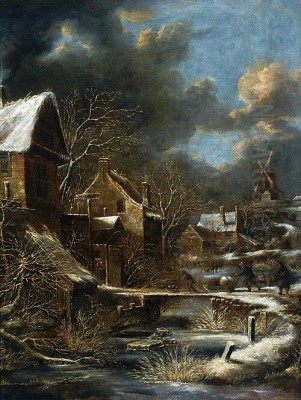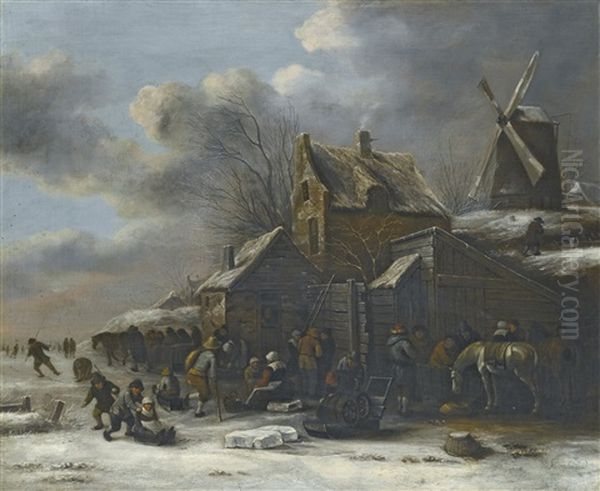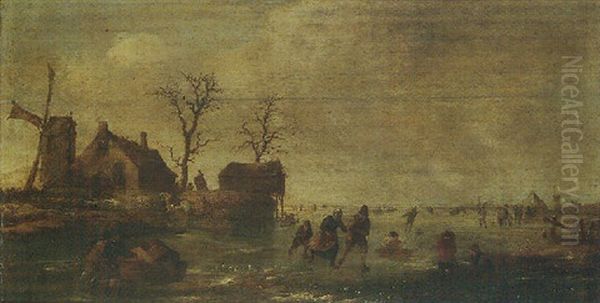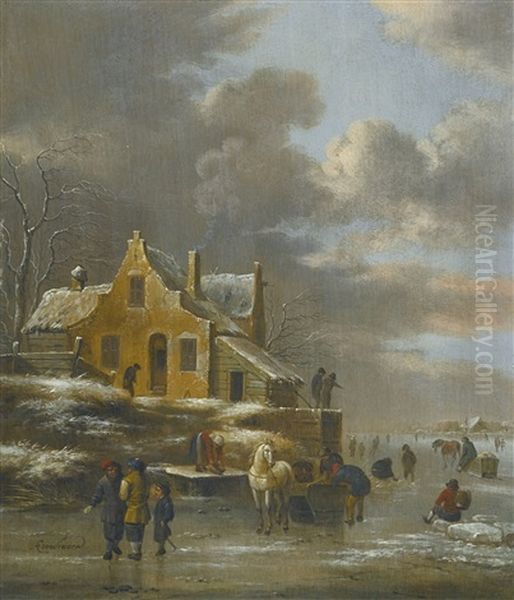
Nicolaes Molenaer, also known as Claes Molenaer, stands as a notable figure within the rich tapestry of the Dutch Golden Age of painting. Active during the 17th century, primarily in the vibrant artistic hub of Haarlem, Molenaer dedicated his career to capturing the essence of the Dutch environment. He is particularly celebrated for his evocative landscape paintings, with a special emphasis on atmospheric winter scenes that continue to resonate with viewers today. His work provides a valuable window into the rural life and natural beauty of the Netherlands during this prosperous era.
Early Life and Artistic Roots
Born in Haarlem, the precise year of Nicolaes Molenaer's birth is subject to some minor variation in sources, often cited as circa 1626 or 1628/1629. He passed away in his native Haarlem and was buried there on August 31, 1676. His family background provides significant context for his artistic path. He was the son of Jan Mientensz. Molenaer, a tailor, and Grietgen Adriaensdr. The family's Catholic faith meant that official baptismal records, common in Protestant churches, are lacking, contributing to the slight uncertainty around his exact birth date.
Significantly, Nicolaes was immersed in an artistic milieu from a young age. He was the nephew of the much more famous and successful painter Jan Miense Molenaer, a prominent figure in the Dutch Golden Age known for his lively genre scenes and portraits, often depicting peasant life and festivities. Furthermore, Nicolaes's own brother, Bartholomeus Molenaer, was also active as a painter in Haarlem. This familial connection to the arts undoubtedly played a role in shaping Nicolaes's own career choice and development.
Joining the Haarlem Guild
A crucial step in the professional life of any aspiring artist in Haarlem during the 17th century was membership in the Guild of St. Luke. This institution regulated the art trade, set standards, and provided a framework for training and professional practice. Nicolaes Molenaer formally joined the Haarlem Guild of St. Luke in 1651. Archival records indicate that he consistently paid his annual dues to the guild up until 1676, the year of his death. This demonstrates his continuous activity as a professional painter based in Haarlem for a quarter of a century.

Membership in the Guild signified recognition by his peers and allowed him to legally sell his paintings and potentially take on apprentices, although records of specific apprentices under Molenaer are scarce. It placed him firmly within the established structure of the Haarlem art world, alongside many other distinguished painters of his time.
Influences and Artistic Development
Nicolaes Molenaer's artistic style did not develop in isolation. Like most painters of his era, his work reflects the influence of leading masters and prevailing trends. The most significant influence often cited is that of Jacob van Ruisdael, arguably the most important and innovative Dutch landscape painter of the Golden Age. Ruisdael's dramatic compositions, his sensitivity to atmosphere, light, and weather, and his often melancholic or majestic views of nature left a clear mark on Molenaer's own landscapes, particularly visible in his treatment of skies and his penchant for winter scenes.
Some sources suggest that Molenaer's earlier work might show affinities with the style of the great Haarlem portraitist Frans Hals, perhaps in the handling of figures within his landscapes, although Molenaer remained primarily focused on the landscape itself. As his style matured, comparisons have been drawn to the work of Adriaen van Ostade, another prominent Haarlem master known for his detailed and often humorous depictions of peasant life in interiors and village settings. This suggests Molenaer integrated elements of genre painting, focusing on the activities of common folk within his broader landscape views.
His development occurred within the broader context of the Haarlem school of landscape painting, which had been pioneered by artists like Esaias van de Velde earlier in the century and included contemporaries such as Jacob van Ruisdael's uncle, Salomon van Ruysdael, known for his tranquil river scenes. Molenaer absorbed these influences, forging his own recognizable, if perhaps less revolutionary, style.
Master of the Winter Landscape
While Nicolaes Molenaer painted various types of landscapes, he earned particular recognition for his winter scenes. This genre had gained popularity in the Low Countries, tracing its roots back to the iconic winter landscapes of Pieter Bruegel the Elder from the previous century, whose compositions were widely disseminated through prints and copies by artists like his son, Pieter Brueghel the Younger. Molenaer continued this tradition but adapted it to the specific tastes and environment of the 17th-century Dutch Republic.

His winter landscapes typically feature frozen canals or rivers bustling with activity – skaters gliding across the ice, figures bundled against the cold, sleds being pushed or pulled. Snow often blankets the roofs of charming village houses and cottages, and the bare branches of trees stand starkly against cool, atmospheric skies. Molenaer excelled at capturing the specific light and feeling of a cold winter's day, often using a palette dominated by whites, greys, blues, and earthy browns to convey the chill. Works like Winter Landscape with a Defense Wall and A River with Skaters exemplify his skill in this popular genre, showcasing both the beauty and the communal life associated with Dutch winters.
Beyond Winter: Diverse Landscapes
Although renowned for his winter scenes, Molenaer's oeuvre included a broader range of landscape subjects. He also painted summer landscapes, depicting the verdant Dutch countryside, village views under warmer skies, and tranquil river scenes that were not frozen over. These works often share the same characteristics as his winter paintings: a focus on recognizable Dutch locations (though often generalized rather than topographically exact), attention to architectural detail in farmhouses and village structures, and an overall sense of peaceful, rural life.
His palette in these non-winter scenes naturally shifted towards greens and warmer earth tones, but often retained a certain softness and subtlety. The influence of Jacob van Ruisdael can still be felt in the way Molenaer composed his scenes and rendered atmospheric effects, such as cloud formations and the play of light across the land. He consistently aimed to create believable, relatable views of the Dutch environment.
Figures in the Landscape
Unlike some landscape painters who focused purely on nature, Nicolaes Molenaer frequently populated his scenes with small figures. These figures are rarely the main subject but serve to animate the landscape, add narrative interest, and provide a sense of scale. They are shown engaged in everyday activities appropriate to the setting: skating, walking, conversing, working on farms, or traveling along country roads.
The way Molenaer integrated these figures might reflect the influence of genre painters active in Haarlem, such as Adriaen van Ostade or indeed his own uncle, Jan Miense Molenaer, who excelled at depicting lively human interaction. Jan Miense Molenaer's wife, Judith Leyster, was another highly accomplished Haarlem artist known for her genre scenes, contributing to the city's strong tradition in this area. Nicolaes Molenaer's figures, while often painted with less detail than those of dedicated genre specialists, are crucial to the charm and accessibility of his landscapes, grounding the natural scenery in human experience.
Collaborations and the Haarlem Context

The close-knit nature of the Haarlem art world, combined with his family connections, suggests potential collaborations. Some sources mention that Nicolaes occasionally collaborated with his more famous uncle, Jan Miense Molenaer. Given Jan Miense's skill with figures and Nicolaes's focus on landscape, such collaborations, where one artist might paint the figures into the other's landscape, were not uncommon during this period, although definitive proof for specific works can be challenging.
Nicolaes worked alongside his brother, Bartholomeus Molenaer, and numerous other talented artists in Haarlem. The city was a powerhouse of artistic production, home to specialists in various genres. Besides those already mentioned, notable contemporaries included Philips Wouwerman, famed for his landscapes featuring horses and battle scenes, and the Flemish-born Adriaen Brouwer, who worked in Haarlem for a time and was influential with his raw depictions of peasant life. Molenaer's focus on native Dutch landscapes contrasted with the work of the Italianate painters like Jan Both or Nicolaes Berchem (who also worked in Haarlem), who depicted idealized, sunny Italian scenery.
A Painter's Pastime: Music
An interesting, lesser-known aspect of Nicolaes Molenaer's life, suggested by his artwork, is a potential interest in music, particularly the violin. Certain paintings attributed to him or his circle depict musical themes. One source mentions a work titled Duet, where the artist reportedly adjusted the depiction of a violin player to reflect correct playing technique. Another source refers to a Self-Portrait with Violin Player, suggesting a personal connection to the instrument.
While caution is needed with attributions, the recurrence of musical motifs, especially the violin, hints at a personal affinity. Music-making was a common theme in Dutch genre painting, symbolizing harmony, leisure, or sometimes vanity, but the specific focus on the violin in relation to Molenaer adds an intriguing layer to his biography, suggesting interests beyond the painter's easel.
Whispers of Legend: The 'Don Juan' Connection
Among the more curious and less substantiated aspects associated with Nicolaes Molenaer is a purported link to the legendary figure of Don Juan. Some accounts or later legends apparently described Molenaer as having lived a somewhat dissolute or "free-living" lifestyle, drawing parallels with the infamous fictional seducer.
It is crucial, however, to treat this information with extreme skepticism. The source material itself indicates this connection is based on legend and speculation, lacking concrete historical evidence. Such stories could arise long after an artist's death, perhaps conflating him with other figures or simply reflecting a romanticized notion of artistic temperament. There is no reliable documentation to confirm that Nicolaes Molenaer lived a life comparable to the Don Juan myth. It remains an unverified, anecdotal whisper surrounding his name.
Artistic Assessment and Legacy
Historically, Nicolaes Molenaer has sometimes been assessed as a competent but perhaps not exceptionally innovative painter within the Dutch Golden Age. Some commentary has described his work as "ordinary" or typical of the period's landscape production, lacking the dramatic power of Jacob van Ruisdael or the refinement of other specialists. However, this assessment perhaps undervalues his consistent quality and his contribution to the popularization of Dutch landscape themes, especially winter scenes.
His work clearly resonated with contemporary buyers and has maintained a presence in art collections over the centuries. His particular skill in capturing the atmosphere of the Dutch winter landscape is undeniable. Furthermore, his depictions of rural life and the Dutch environment are considered to have provided inspiration for later generations of artists, particularly Romantic painters in Germany, the Netherlands, and Belgium during the 19th century who looked back to the Golden Age for models of national landscape painting.
Molenaer in Museums
Today, the legacy of Nicolaes Molenaer is preserved in the collections of numerous museums across the world. His paintings offer valuable examples of 17th-century Dutch landscape art. Prominent institutions holding his works include the Rijksmuseum in Amsterdam, the national museum of the Netherlands, and the Museum Boijmans Van Beuningen in Rotterdam. The presence of his paintings in these major public collections ensures his continued visibility and allows audiences to appreciate his contribution to the Dutch Golden Age firsthand. Recent research and exhibitions sometimes bring renewed attention to lesser-known masters like Molenaer, occasionally leading to new discoveries or re-attributions of works.
Final Years and Conclusion
Nicolaes Molenaer remained active as a painter in Haarlem until his death in 1676. He was buried in his hometown, leaving behind a substantial body of work focused on the landscapes he knew intimately. As a member of an artistic family and the Haarlem Guild of St. Luke, he was fully integrated into the professional art world of his time. While perhaps overshadowed by giants like Jacob van Ruisdael or Rembrandt, Molenaer carved out a niche for himself, particularly with his atmospheric and engaging winter scenes.
He stands as a dedicated chronicler of the Dutch countryside and village life, capturing the specific light, weather, and activities that defined the environment of the Dutch Republic in its Golden Age. His paintings, characterized by their accessible subjects, soft palettes, and detailed observation, continue to offer a charming and valuable glimpse into the world of 17th-century Holland. Nicolaes Molenaer remains a significant representative of the Haarlem school of landscape painting.